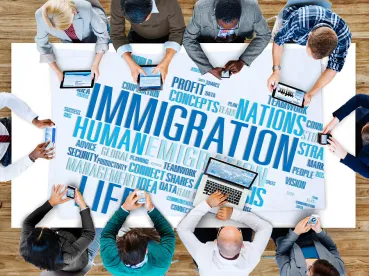In October 2020, the U.S. Department of Labor (“DOL”) and U.S. Citizenship and Immigration Services (“USCIS”) each published an interim final rule (“IFR”), titled respectively, “Restructuring of H-1B/H-1B1/E-3 and PERM Wage Levels” and “Strengthening the H-1B Nonimmigrant Visa Classification Program.” By issuing these regulations as IFRs, the agencies have avoided (arguably improperly) having to follow required rulemaking procedures, which among other things, mandate notice and a public comment period. (See our prior Immigration Alert.) The DOL IFR took effect immediately, while the USCIS IFR will take effect on December 7, 2020.
The IFRs substantially impact the future of the H-1B process. For example, they narrow the definition of an H-1B specialty occupation, impose stricter scrutiny of an employee’s qualifications for the classification, add restrictions to the placement of H-1B employees at third-party work sites, and increase minimum wage requirements for an H-1B sponsorship. The IFRs have been challenged (see below); if left in place, however, they will likely increase the rate of H-1B denials.
The USCIS’s IFR, for example, will require the agency to apply a rigid standard of review as to the nature of the offered position, its purported specialty, and the foreign national’s qualifications for the position, particularly if the individual’s field of study was not one that normally fits within the occupation. Thus, employers may expect that H-1B petitions that previously were routinely approved will now become subject to challenge.
The DOL’s IFR, adopted with almost no notice, significantly increased the minimum wage requirement under the DOL’s Occupational Employment Statistics wage survey. For example, before the rule became effective, a level 1 wage for a software developer in the Los Angeles County area was $78,125 per year; it is now $116,418. Of more significance, the IFR replaced the DOL’s prior four-tier wage level system applicable to many advanced positons with a single minimum wage of $208,000. The DOL’s IFR does, however, permit employers to demonstrate an industry’s prevailing wage for any H-1B offered position through the use of an alternative wage survey that is acceptable to the agencies, if available, or any other wage source that uses a sample size of at least three employers and 30 employees.
The U.S. Chamber of Commerce (in federal court in California) and the American Immigration Lawyers Association (in federal court in the District of Columbia), along with numerous amicus briefs joined by the hi-tech sector and academic institutions, have sued to overturn the IFRs. A hearing on their request for injunctive relief is set for the end of November 2020. Moreover, with the upcoming change in administration, President-Elect Joe Biden will have the executive authority to revoke (and is leaning toward revoking) these IFRs when he enters office.
USCIS Releases Proposed Regulations to Change the H-1B Cap Registration and Selection Process for 2021
On November 2, 2020, USCIS published proposed regulations that, if adopted, will change the H-1B selection process for next year’s H-1B cap registration. Currently, USCIS annually selects 65,000 petitions filed for the H-1B regular cap and 20,000 petitions for the H-1B U.S. master degree cap. When more petitions are submitted than available numbers, USCIS will randomly select H-1B cases through a computer-generated lottery for further processing. Cases that are not selected in the lottery are not eligible for filing the H-1B petition and must wait until the following year to try again.
Under the proposed rule, USCIS will give a preference to H-1B petitions that will pay the highest prevailing wages. If there are still H-1B numbers available after the first lottery is completed for petitions willing to pay the highest prevailing wages, USCIS will take those remaining petitions and add them to the petitions willing to pay the second-highest wage level and then conduct another lottery. This process will continue until all the 65,000 and 20,000 cap petitions have been exhausted. Upon being sworn in as President, Joe Biden will have the authority, through agency rulemaking, to rescind the regulation (and is leaning toward doing so) should it be adopted.
Temporary Protected Status Extended for South Sudan
On November 5, 2020, USCIS announced extended Temporary Protected Status (“TPS”) for the South Sudan. Any national of South Sudan present in the United States will be allowed to legally stay and work under TPS through May 2, 2022. An employer that hires a South Sudanese national with TPS should advise the employee that he or she has work authorization through May 2, 2022. To qualify, however, the individual must reregister with USCIS between November 2, 2020, and January 4, 2021. An employer that employs a South Sudanese national with TPS status but who holds an expired or about-to-expire EAD work permit application may continue to employ the South Sudanese employee until May 1, 2021, as long as the South Sudanese employee receives a new EAD employment authorization card by that date. To verify TPS work authorization on Form I-9, the South Sudan beneficiary will need to present his or her prior EAD work authorization card with Category Code of A12 or C19, and the employer should enter “May 1, 2021” as the new expiration date to complete and verify the Form I-9. The employer should also calendar that date to re-verify the Form I-9 on May 2, 2021, for the South Sudanese employee. At that time, the South Sudanese employee must provide new proof of TPS work authorization, which should be an EAD card with a May 2, 2022, expiration date.




 />i
/>i

